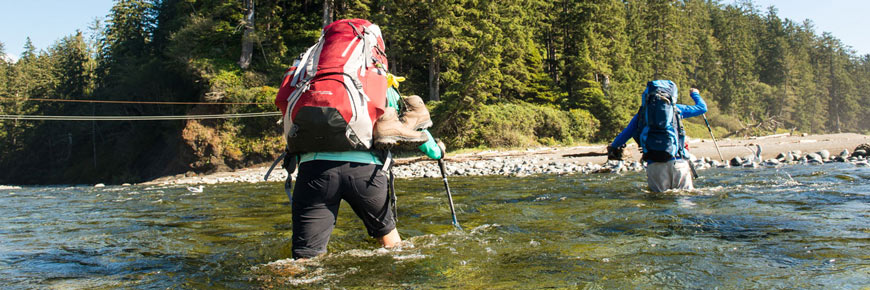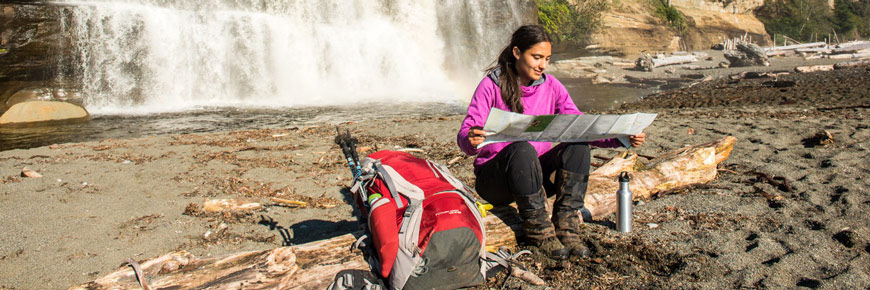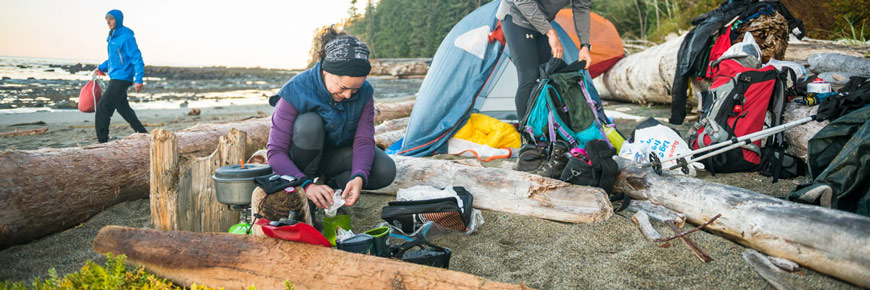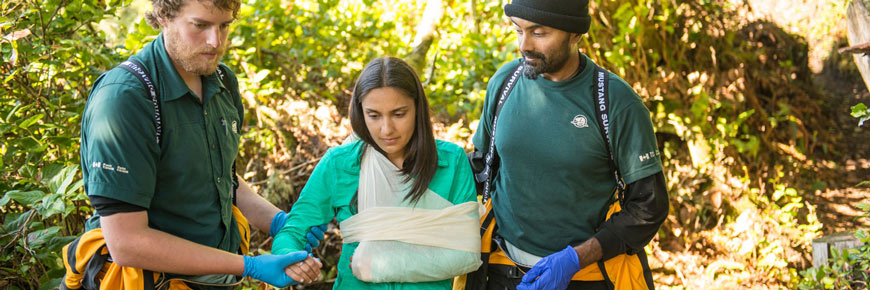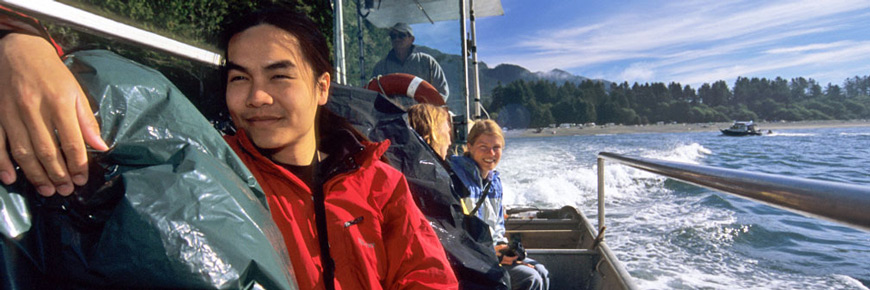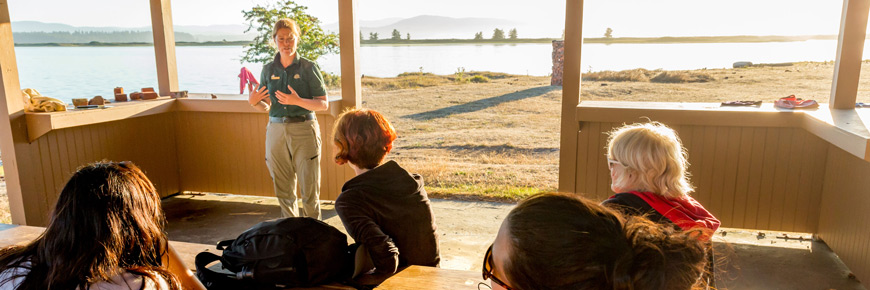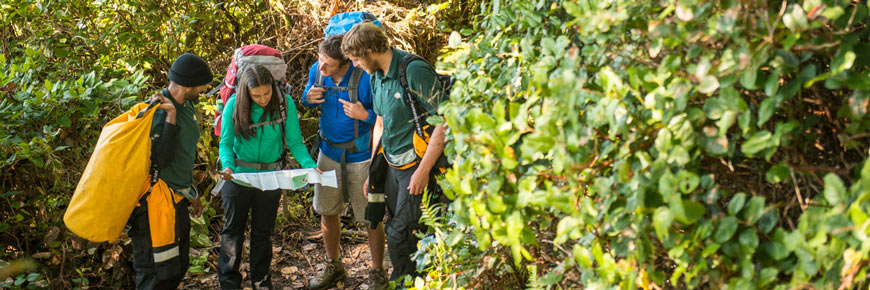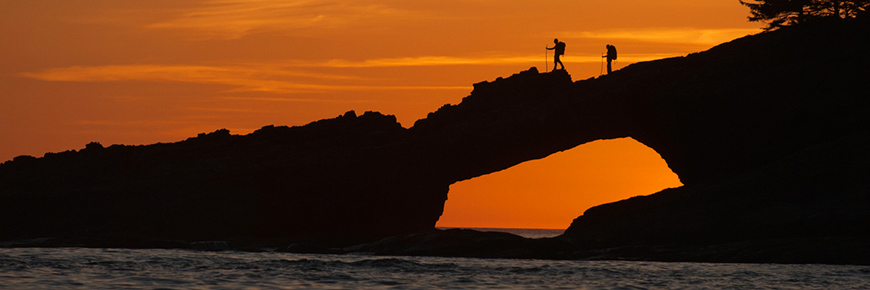
West Coast Trail: Hike of a lifetime
Pacific Rim National Park Reserve
Balaats’adt (Nitinaht Village) Trailhead
Information on hiking in or out of the West Coast Trail's midway trailhead located in the Village of Nitinaht.
Challenges
Be prepared for the challenges you might experience on the West Coast Trail.
Planning
Plan for your backcountry hiking trip on the West Coast Trail including, fees, group size, and orientation sessions.
Reservations
Learn more about how to make a reservation to hike the West Coast Trail in Pacific Rim National Park Reserve.
Packing
What to pack for your backcountry hiking trip on the West Coast Trail.
Transportation
Getting to and from Pachena Bay, Gordon River and Nitinaht Trailheads on the West Coast Trail.
Safety
Learn how to have a safe and enjoyable trip when hiking the West Coast Trail in Pacific Rim National Park Reserve.
Frequently asked questions
Read the answers to frequently asked questions about hiking the West Coast Trail in Pacific Rim National Park Reserve.
Related links
Links to other helpful resources for booking your trip on the West Coast Trail.
Visit the Pacific Rim National Park Reserve COVID-19 page for updates on park facilities and services.Please note:
History | Reservations | Resources
Is this hike right for you?
Before you decide to make a West Coast Trail reservation for yourself, learn what you are signing up for and make sure this hike is right for you.
Before you make a reservation:
1. Read the
West Coast Trail Hiker Preparation Guide
Transcript
[music]Animated title sequence: The West Coast Trail, Pacific Rim National Park Reserve, Parks Canada logo
[Hikers enjoying the trail]
[Narrator] The West Coast Trail is a multi-day backcountry hike along the west shoreline of Vancouver Island.
[Animated map of the West Coast Trail] [Animated text: West Coast Trail | 6 to 8 Days | 75 km]
"Spanning 75 kilometres from Pachena Bay to Gordon River, " the trail lies in the traditional territories of the Huu-ay-aht, Ditidaht, and Pacheedaht First Nations.
[Montage of Huu-ay-aht, Ditidaht, and Pacheedaht First Nations people cutting down trees, clearing brush, and conversing with camera man on the West Coast Trail]
These Nations have been here since time immemorial and continue to call Vancouver Island home. Today, through cooperative management, the West Coast Trail Guardians from each of these Nations help maintain the trail, share stories and welcome hikers.
[Hikers encountering bridges, ladders and uneven terrain on West Coast Trail.]
This is one of British Columbia’s most challenging hiking routes. It covers extremely difficult terrain and should only be attempted by seasoned backcountry hikers with multi-day trek experience.
[Hikers with large backpacks walking along beach]
Before reserving your space, know what you’re signing up for to make sure this hike is for you.
[Animated title sequence: Is the West Coast Trail Right for You?]
[Montage of West Coast Trail hikers descending tall ladders, walking along beach with other hikers, and balancing on narrow sections of raised trail.]
"Hiking the West Coast Trail is difficult, even for experienced hikers." Most people will spend between 6 and 8 days in the backcountry, when travelling from end-to-end. There’s also a mid-way entry point at Nitinaht Village, which can shorten your journey by a few days.
[Hikers walking on slippery rocks, crossing a flowing river, propelling the cable car and traipsing through ankle-deep deep mud.]
Strenuous terrain, fast-flowing river crossings, ladders and cable cars, mud and rain are guaranteed challenges. On top of that, you’ll have a heavy backpack and will likely be exhausted.
Animated text: Did You Know? Help can take up to 24 hours to reach you. [Search and Rescue boat arriving to shore]
Did you know that if you get injured on the trail, it can take up to 24 hours for help to reach you? Before you decide to take on the trail, ask yourself these questions:
Animated text: Yes or No. Hiked overnight before? [Hiker setting up tent]
First, have you and everyone in your group done a multi-day, overnight backcountry hike before?
[Confident hiker explaining something to other hikers]
Remember, an experienced hiker can’t compensate for someone inexperienced.
Animated text: Yes or No. Able to hike long distances?
Number two: can you hike long distances over rough terrain with a heavy pack? You’ll be carrying all your supplies on your back.
[Hiker climbing down ladder with large, seemingly havy backpack]
Climbing up ladders and over slippery ground with that extra weight is difficult.
Animated text: Yes or No. Are plans flexible?
Third, are your plans flexible in case of delays?
[Hikers on West Coast Trail during heavy rain and walking quickly along a narrow section of trail]
Forging ahead in bad weather, hiking late in the day or rushing to finish often leads to injury.
[Montage of hikers standing on bank of crashing river, deciding not to cross and waiting out a storm]
Floodwaters, repairs or an accident on the trail can delay your trip by days. If you can’t be flexible, rethink your plan.
Animated text: Yes or No. Healthy and injury-free?
Next, are you healthy and injury-free?
Animated text: Recent surgery, Concussion, Heart condition, Recurring injuries
If you’ve had a recent surgery or concussion, suffer from a heart condition, or struggle with recurring knee, ankle or back injuries, this hike is not for you.
[Search and Rescue team flying over trail in helicopter and assisting injured hiker.]
Joint injuries are a leading cause of evacuation —even something as small as an aggravated knee should be cleared by your doctor.
Animated text: Yes or No. Everyone over the age of 12?
Finally, is everyone in your group over the age of 12? All hikers must be at least 6 years old to get an overnight permit, though the trail isn’t recommended for anyone under 12.
Animation: Adult and child hiker with red "X" flashing over child, indicating children under twelve should not attempt the West Coast Trail.
If you have children, it's best to choose another hike.
"Animated text: Yes or No? Animated checklist with all five items checked off: - Hiked overnight before? - Able to hike long distances? - Are plans flexible? - Healthy and injury-free? - Everyone over the age of 12?
"If you answered YES to all five questions, the West Coast Trail may be a great fit for you.
Animated text: reservation.pc.gc.ca
Reserve your spot early, as hiking allocations go quickly!
"Animated checklist with four items checked off and one list item with a red ""X"" beside it: - Hiked overnight before? - Able to hike long distances? - Are plans flexible? - Healthy and injury-free? - Everyone over the age of 12?
"If you answered NO to EVEN ONE of these questions, consider one of many beautiful alternative hikes.
Animated list of alternative hikes: Juan de Fuca Provincial Park and Marine Trail – Vancouver, BC; Strathcona Provincial Park – Vancouver, BC; Wild Pacific Trail - Ucluelet, BC; Wild Side Trail - Flores Island, Ahousaht, BC
Now, it’s time to prepare…
Animated title sequence: How Do I Prepare for the West Coast Trail?
[West Coast Trail hikers walking over challenging, uneven terrain]
The West Coast Trail isn’t a hike you can decide to do on a whim —it’s a challenging trek, requiring careful preparation.
"Animated title: When to Visit Animated text: Jan, Feb, Mar, Apr, May, Jun, Jul, Aug, Sep, Oct, Nov, Dec [May to August highlighted in green]
"The trail is reservable from May to September each year.
"Animated title: Weather Animated text: 14 degrees celsius, 330 cm of rainfall
"Summer temperatures average 14°C and the area sees about 330 cm rainfall annually.
Animation: rainclouds hovering over May and June
May and June are particularly wet. Before setting out, there are a few things you need to do: First, put together a training plan.
"[Man outside on a training hike with his backpack and hiking boots on.] Animation: Freeweight icon, heartbeat icon Animated text: 3 months beforehand
"Start a full-body strength and cardio program at least 3 months before your hike with uphill endurance training in mind. Practice hiking with your weighted pack and hiking boots well in advance.
[Hiker packing up campsite and typing up trip plan]
Remember, this should not be your first overnight backpacking experience! Before you leave, write out a trip plan and share it with your emergency contact.
Animated text: Where are you going? Who are you travelling with? What's your expected itinerary? What should they do if you don't return?
Include where you’re going, with whom, your nightly itinerary, an anticipated return date and instructions on what to do if you don’t return.
Because there are three access points to the trail,
[Search and Rescue helicopter landing on beach]
these details will be extremely helpful if search and rescue is required. Finally, while you’re on the trail, keep these safety tips in mind:
Animated text: Safety Tips. Take your time.
Move with caution, take breaks and set reasonable travel expectations.
[Montage of hikers rushing over tree roots and uneven surfaces on the West Coast Trail, then examples of hikers taking their time]
Accidents happen when people are tired or moving too fast. Always assume terrain is slippery and hike at the pace of your slowest group member.
Animated text: Safety Tips. Stay warm and dry.
Stay warm and dry.
[Hikers putting on sweaters and hiking during heavy downpour]
Injury and hypothermia happen more easily in cool, rainy weather, which is common on the trail, even in summer.
Animated text: Saftey Tips. Stay hydrated and well-fed
Keep hydrated and well-fed. It’s easy to become dehydrated and undernourished on the trail.
[Hikers stopping for snacks and mixing up trail food nad collecting water from streams, then filtering or boiling it]
You should be eating plenty of nutritious, high calorie food and drinking enough that you need to make regular pit stops —even on cooler days. Drinking water can be collected from most rivers and creeks —but to be safe, you should always carry enough to get you to the next large fresh water source. Always collect your water upstream and purify before drinking.
Animated text: Saftey Tips. Treat structures with respect
Treat the structures with respect.
[Hikers climbing ladder one at a time, loading gear in cable car before getting in and practicing general cable car safety
Limit the number of hikers at a time on ladders and cable cars and secure your equipment, straps, and clothing in the car before leaving the platform. Let the cable car come to a complete stop before pulling the rope to move yourself to the other side and keep your fingers and hair away from the pulleys!
Animated text: Saftey Tips. Be prepared for floodwaters
Be prepared to wait for floodwaters to subside at river crossings, which can take days.
[Hikers stopping to asses flowing river depth]
Don’t cross when water is flowing above the knees, as currents can easily sweep you downstream.
Animated text: Saftey Tips. Use tide tables
Use your tide tables and West Coast Trail map
[Hiker trapped by impassable headlands]
to avoid being trapped or cut off by impassable headlands.
"Animated text: Saftey Tips. Store food properly [Hiker locking up food in metal wildlife-proof bin]
"Always hang your food and garbage or store them in a wildlife-proof bin at the campsites so you don’t attract wild animals.
Animated text: Saftey Tips. Don't rely on cell phone
Lastly, there’s limited cell service on the trail.
[Hiker sitting on log, setting up safety device before heading out on hike]
If you have a safety device like a “SPOT”, “InReach” or satellite phone, learn to use it beforehand and have emergency messages pre-entered, just in case. Now that you’re familiar with the trail, it’s time to start packing.
[Animated title sequence: What Should I Pack for the West Coast Trail?]
[Hikers strapping on gators by stream and packing up campsite]
Your experience on the West Coast Trail will be far better if you’re comfortable and well-prepared.
[Hiker adjusting straps on backpack]
The first thing you’ll need is: A well-fitted backpack with a padded hip belt to distribute weight.
[Animated hiker icon offering supporting visual for 15-20 % bodyweight]
Your pack should weigh no more than 15-20% of your body weight.
[Hiker hanging backpack on outdoor scale at trail head and checking weight]
Weigh your bag as you pack and keep asking, “Do I really need this?”.
[Hiker adding unneeded items to bag with red "X" flashing overtop, indicating items are unnecessary]
Things like electronics, solar panels, and instruments are tempting but downtime on the trail
[Hikers boiling a pot of water on a camp stove and conversing around a campfire]
is usually spent cooking, socializing or sleeping. Sharing items like a tent, stove, pots and pans with your group can lighten the load and make everyone’s hike more comfortable!
[Hiker lining backpack with black garbage bag, then sealing clothes in a second garbage bag and placing in backpack]
Line your pack with a heavy-duty garbage bag or waterproof liner to protect your gear. You can also seal your sleeping bag and night clothes in an extra garbage or dry bag for added security.
"[Hiker walking around campsite testing pack weight] [Hiker walking through parking lot with items swinging off side and red ""X' flashing over the improperly packed bag]
"All your equipment should fit inside your pack, with heavier items near the bottom. Don’t leave anything swinging off the sides —it could get caught on trees or rocks and throw you off balance.
[Hikers lacing up boots and testing on slippery surfaces]
The next thing you need is proper hiking boots. Quality boots with good ankle and arch support are a must. Opt for soft rubber soles for traction on slippery surfaces and break your boots in at least one month before your hike
[Photo of tent, sleeping bag, and sleeping pad lined up with animated labels]
For shelter, a tent with a waterproof fly is necessary. You’ll also need a synthetic-filled sleeping bag and a sleeping pad for proper insulation at night.
[Closeup of hiker stirring pot of oats over a camp stove]
For meals, pack foods that are high energy, lightweight, and quick cooking,
[Photo of dehydrated meal, dried fruit and almonds, energy bars, and bag of oatmeal, with animated labels]
like dehydrated meals you can add water to, energy bars, dried fruit and nuts, and oatmeal.
[Person adjusting temperature on camp stove and writing out meal plan on pad of paper]
Bring a lightweight stove and fuel and plan your meals before your trip to keep pack weight to a minimum.
[Hiker going through backpack and pulling out sealed bag of trail food]
It’s a good idea to have at least a day’s worth of emergency rations in case you end up on the trail longer than expected.
[Photo of rain gear, under layers, rain gear, socks, hat and gloves]
For clothing, bring a waterproof jacket and pants, quick-dry under-layers that will stay warm when wet, like wool, fleece and Polypropylene, as well as proper hiking socks, a warm hat, and gloves.
[Hikers walking through a downpour]
Avoid cotton and jean materials—again, hypothermia is a risk if you get wet, Even in summer, the coast is typically blanketed with fog, meaning cool, damp conditions.
so quick-dry clothing is essential.
[Animated icons of a watch, a bandaid, rope, a water droplet, walking sticks, a lighter, and an emergency signaling device]
Other important items to remember are a watch to use with tide tables, a first aid kit including prescription medication, 15 metres of rope to hang your food, a water container and purification system, collapsible hiking poles, a waterproof fire starter and, if possible, an emergency signaling device…
[Hikers trying to find the right way to go]
Remember, your cellphone will be unreliable on the trail.
Animated text: parkscanada.ca/wct-brochures
There are a few other items to consider bringing. Download the West Coast Trail Hiker Preparation Guide from the Parks Canada website for the full list.
[Hikers taking ofdf backpacks and sitting down in red Parks Canada chairs to enjoy the view]
The West Coast Trail is an incredible bucket list experience —one you’ll remember forever. Now that you’re prepared, it’s time to get out there and start training. Happy trails!
Credits:
"[Parks Canada logo Like. Comment. Share. PC.GC.CA social media logos]
"Are you prepared?
The West Coast Trail (WCT) is an iconic backcountry, multi-day backpacking trail that is a bucket list challenge for many hikers. It is an experience that can bring even the most experienced hikers to their knees. Those who are well prepared physically, mentally, and equipment-wise, come away with tales of grit.
Hikers climb more than 100 ladders with a heavy pack, trudge through deep mud, wade through mountain-fed rivers in fast-flowing hip-deep waters, and push through whatever weather the wild West Coast delivers — often driving wind and rain.
History
The 75-kilometre (47-mile) West Coast Trail is part of the ancient paths and paddling routes used for trade and travel by first nations. Huuay-aht, Ditidaht, and Pacheedaht villages and camps were well established before the foreign sailing ships started to arrive off this coast over 200 years ago. As the years passed and the number of ships sailing the Juan de Fuca Strait increased, so too did the number of shipwrecks and drownings along the coast. In time, the coastline became known as “the Graveyard of the Pacific.”
More history
In 1906, when the steamship Valencia went down with the horrific loss of more than 125 lives, the public outcry prompted the Canadian government into further action: Pachena Lighthouse was constructed in 1907; lifesaving stations were established at Cloo-ose and Bamfield; the telegraph route was upgraded to become the Dominion Life Saving Trail, complete with six shelters stocked with provisions for both shipwreck victims and their rescuers. As navigation technology improved, many of these measures became obsolete and were abandoned.
In 1970, Pacific Rim National Park Reserve was established and in 1973, the lifesaving trail was included in the national park reserve as a recreational hiking trail, beginning a new chapter in its history. Today, over 7,500 backpackers hike the West Coast Trail every year. They come to see the beauty, experience the challenges, and walk the path of those that came before them.
Reservations
The West Coast Trail is OPEN May 1 to September 30.
Reservations for the West Coast Trail can be made for the 2024 season as of:
- 8 a.m. PST on January 22, 2024. To reserve call 1-877-RESERVE or visit www.reservation.pc.gc.ca
West Coast Trail Reservations
Balaats’adt (Nitinaht Village) Trailhead: 3-5 day adventures
The West Coast Trail can be intimidating, even to the most seasoned adventure-seeker. A mid-point entrance at Nitinaht Narrows (only accessible by water taxi from Balaats’adt (Nitinaht Village)), allows hikers to tackle a shorter portion.
Cape Beale Headlands
Located near Bamfield, this rugged section of shoreline is home to the historic Cape Beale lighthouse. Cape Beale Headlands provide a chance for visitors to sample the same terrain as the 75 km West Coast Trail. These challenging hikes wind through temperate rainforest to spectacular west coast beaches. All day and overnight users of the Cape Beale Headlands are required to register at the West Coast Trail Information Office at Pachena Bay.
Reservations
Keeha Beach is OPEN for overnight visitors May 1 to September 30.
Anyone camping at Keeha Beach must have a backcountry use permit. Backcountry use permits are only available through the Parks Canada Reservation System. No spaces will be available for stand-by (first come first serve).
Reservations for Keeha Beach can be made for the 2024 season as of:
- 8 a.m. PST on January 19, 2024. To reserve call 1-877-RESERVE or visit www.reservation.pc.gc.ca
The Nitinaht Triangle remains closed until further notice.
Resources
Related links
- ʔapsčiik t̓ašii (Multi-use pathway)
- 150 adventures for your bucket list
- Birding
- Boating
- Camping
- Cycling, mountain biking, and e-biking
- First Nations cultural experiences
- Fishing
- Geocaching
- Hiking
- Kapyong Memorial at Radar Hill
- Kwisitis Visitor Centre
- Red Chairs
- School and group programs
- Storm watching
- Surfing
- Volunteer opportunities
- Licensed operators
- Date modified :
